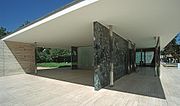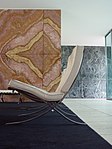Barcelona pavilion
The exhibition pavilion of the German Empire at the 1929 World Exhibition in Barcelona ( Exposició Internacional de Barcelona ), designed by the German architect Ludwig Mies van der Rohe, is known as the Barcelona Pavilion (in Catalan Pavelló alemany "German Pavilion" or Pavelló Mies van der Rohe ) (1886–1969) designed. The German Pavilion served as a way of presenting itself to the Weimar Republic and, through its novelty and precision, was intended to symbolize the efficiency of German industry and craft. Not least because of its reconstruction, the pavilion is confirmed as one of the architectural icons of the 20th century.
construction

With the building, which was to set the style for modern architecture, Mies van der Rohe realized two of his basic design principles:
- In the " free floor plan ", the walls, freed from their load-bearing function, became light room dividers or areas in the room.
- The "flowing space" connected the living area with the outside area through the almost transparent walls with their large glass fronts and filigree steel supports.
Similar style elements and basic ideas can be found in the Villa Tugendhat, which was built at the same time . They were consistently followed up around 20 years later at Farnsworth House .
The reinforced concrete roof rested on filigree steel supports, between which wall elements and glass panes reached from the ceiling to the floor. The floor, roof and wall surface did not enclose the room, but only provided boundary indications. The result was a clear structure, which, however, enabled different spatial relationships.
In the outside area there was a water basin, in the middle of which the female bronze figure “The Morning” by the artist Georg Kolbe rose from the water. The bottom of the water basin was lined with black glass plates.
Travertine and serpentinite were used for the walls and floors , as well as onyx marble for an inner wall, as well as the green Tinos verde antico from Tinos . All panels were fastened with natural stone facade anchors.
Barcelona armchair with reddish onyx marble wall in the background
Kolbe's sculpture The morning in the water basin
Mies van der Rohe also designed the furniture for this pavilion, of which the Barcelona armchair became world famous (frame made of drawn flat steel, chrome-plated, button upholstery, loose cushions, leather cover).
The sculpture Morgen by Georg Kolbe
The sculpture Morgen by the German sculptor and draftsman Georg Kolbe (1877–1947) was originally created in 1925 for the Cecilien Gardens in Berlin. Here she stands across from a second figure named Evening . The third figure in the Nacht group stands in the atrium of the Haus des Rundfunks in Berlin-Charlottenburg. The morning in the Barcelona Pavilion was originally a tinted plaster model that was destroyed on the return transport from Barcelona to Berlin. Today a bronze cast of the Kolbe sculpture stands in the basin of the rebuilt pavilion.
reconstruction
After the World Exhibition ended in 1929, the pavilion was demolished and the building materials that could be used were sold. Some parts of it are now in the old building of the Saxon State Parliament in Dresden . Between 1983 and 1986 the city of Barcelona, under the direction of the architects Cristian Cirici, Fernando Ramos and Ignasi de Solà-Morales, reconstructed the pavilion according to the original plans in its original location.
literature
- Ursel Berger, Thomas Pavel (Ed.): Barcelona Pavilion. Mies van der Rohe and Kolbe. Architecture and sculpture. Jovis Verlag, Berlin 2006, ISBN 978-3-939633-06-8 .
- Josep Quetglas: The glass horror - Mies van der Rohe's pavilion in Barcelona , Birkhäuser, Basel 2001, ISBN 3-7643-6340-1 , 191 pages, mainly illustrated in b / w.
- Ursel Berger: Georg Kolbe. Life and work. Gebr. Mann Verlag, Berlin 1990, ISBN 3-7861-1589-3 .
- Dietrich Neumann : Architecture and Politics. The Barcelona Pavilion by Mies van der Rohe. Birkhäuser, Basel 2020, ISBN 978-3-0356-1979-9 .
- Dietrich Neumann (Ed.): The Barcelona Pavilion by Mies van der Rohe. A hundred texts 1929–2019. Birkhäuser, Basel 2020, ISBN 978-3-0356-1980-5 .
Movie
- The German Barcelona Pavilion. Documentation, France, 2009, 26 minutes, director: Richard Copans, production: arte France, series: Baukunst, German first broadcast: October 6, 2009 on arte. Summary ( memento from April 18, 2013 in the web archive archive.today ).
Web links
- Barcelona Pavilion as a 3D model in SketchUp's 3D warehouse
- The Barcelona Pavilion. Fundació Mies van der Rohe, Barcelona (English)
- Morning Cleaning, Mies van der Rohe Foundation, Barcelona 1999. Work by photographer Jeff Wall in the Walker Art Center
Coordinates: 41 ° 22 ′ 14 ″ N , 2 ° 9 ′ 0 ″ E







